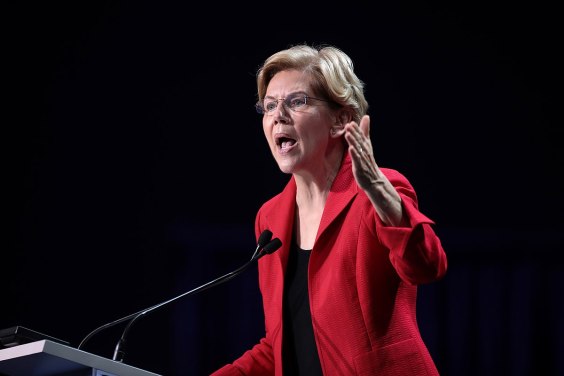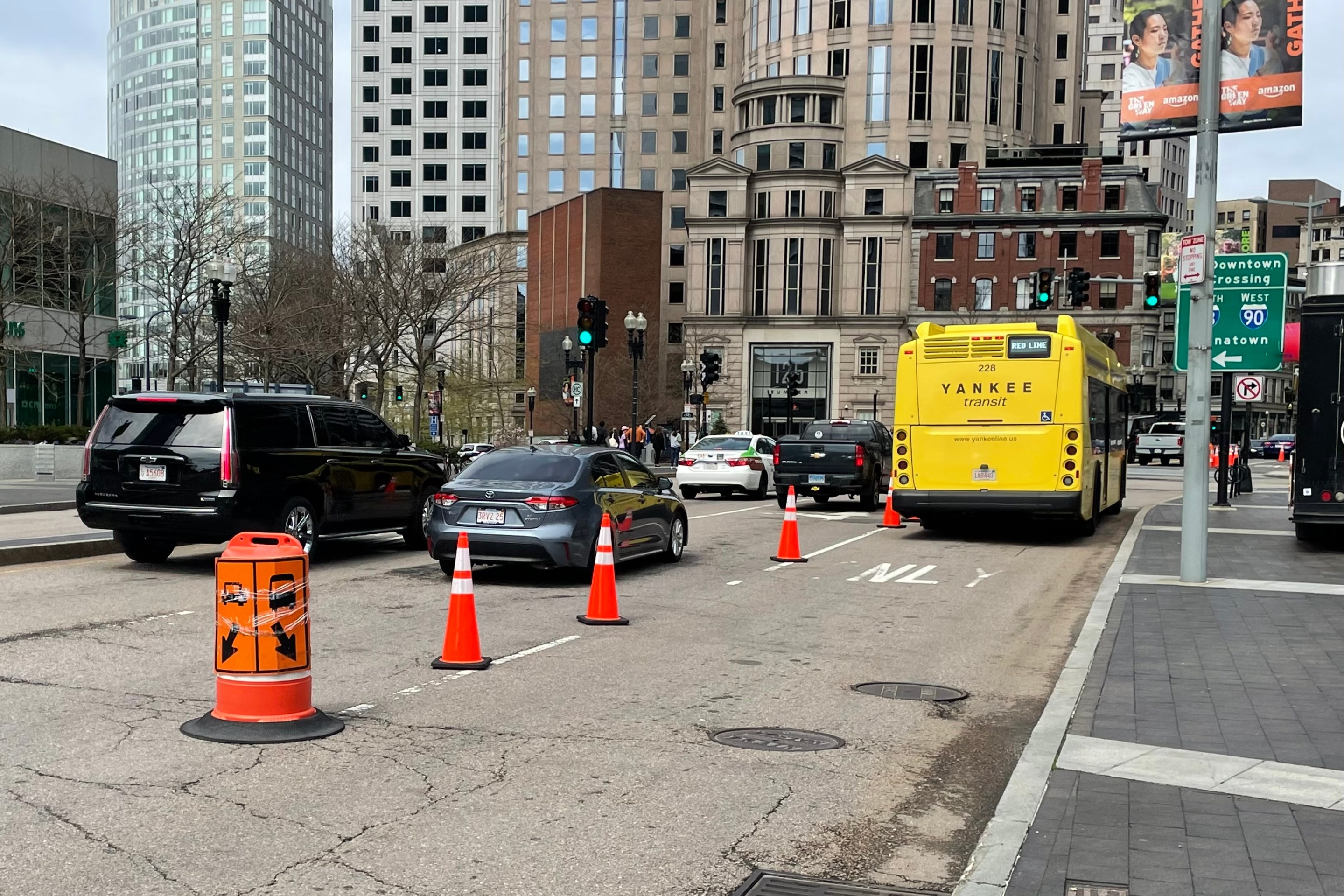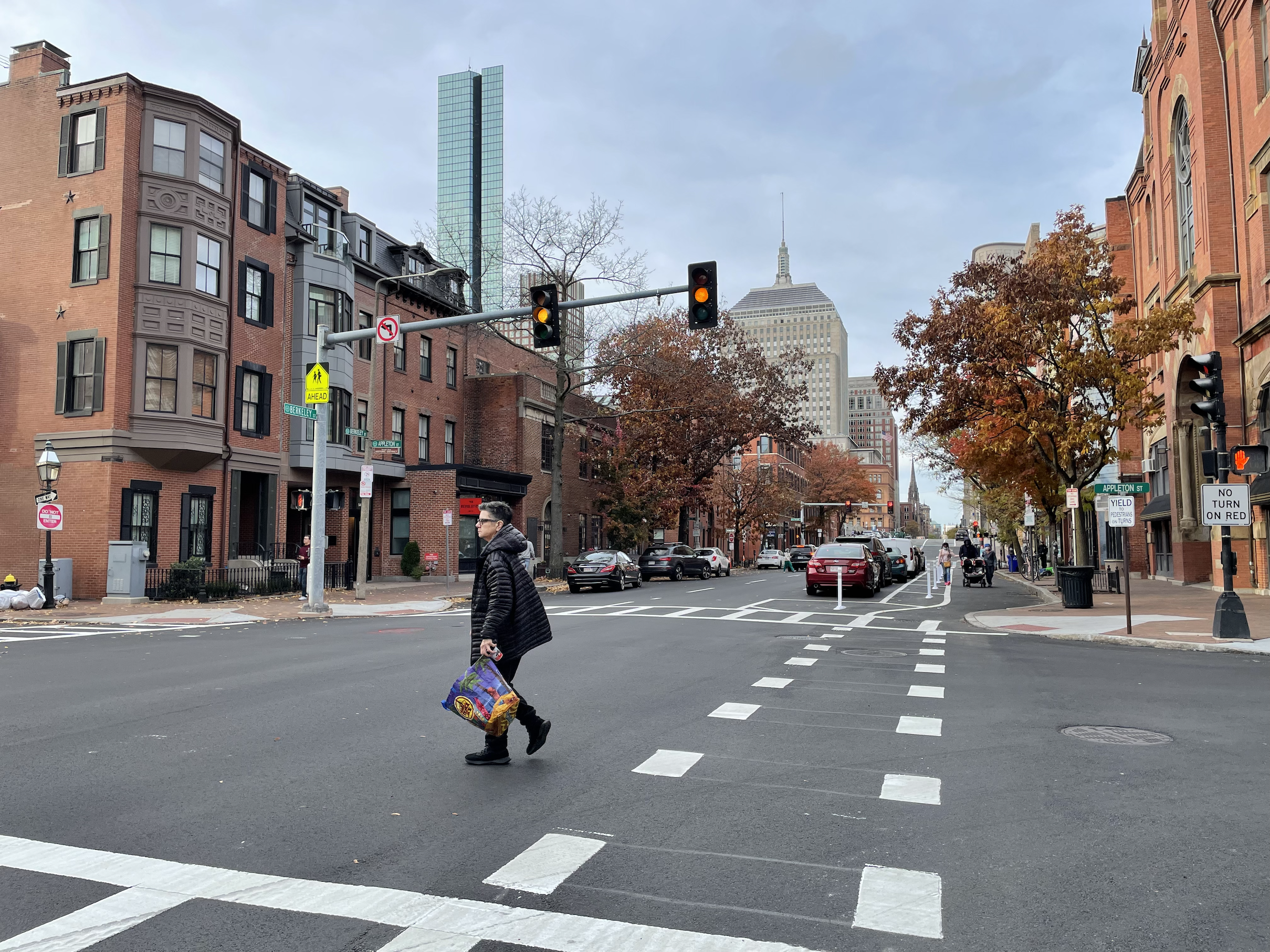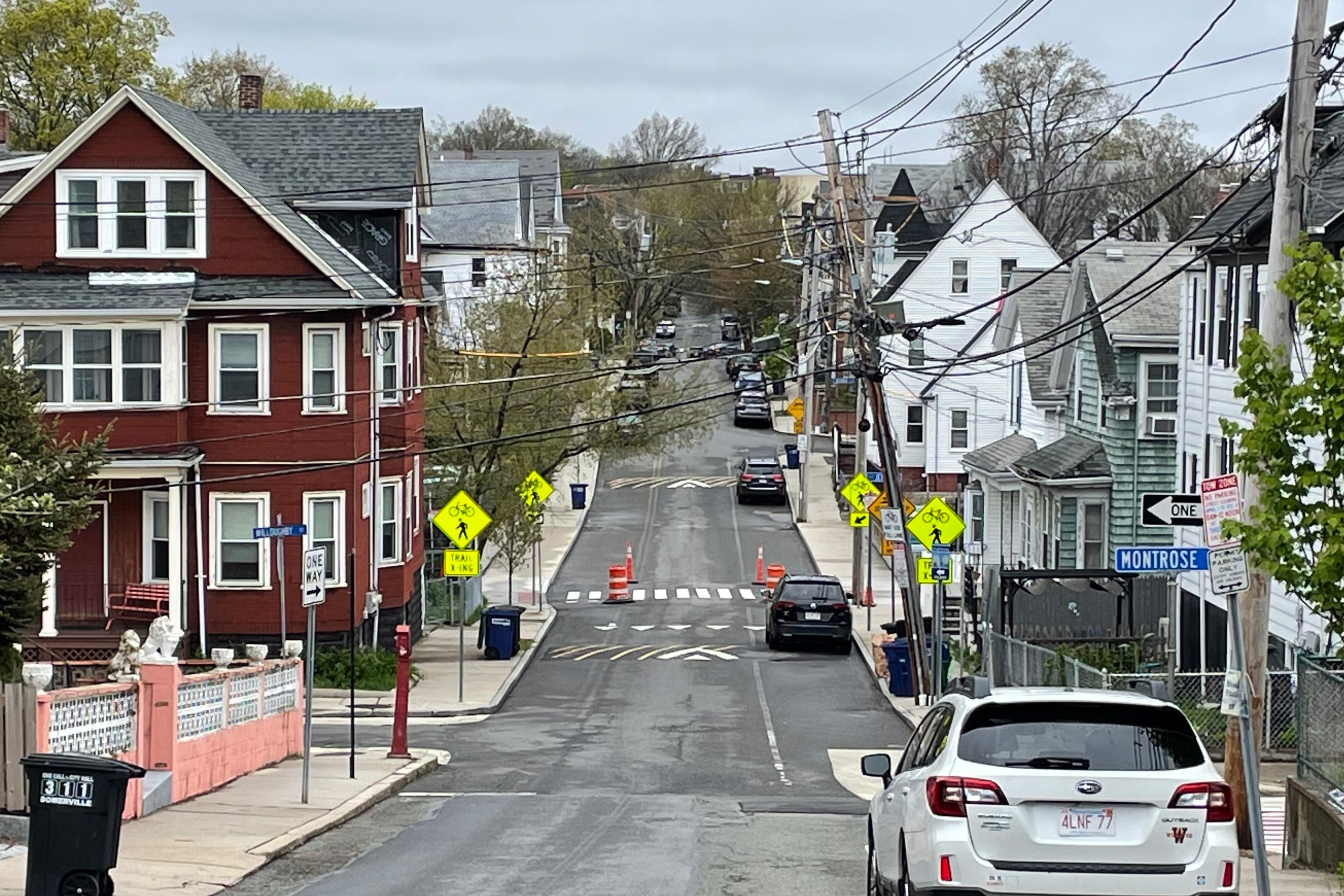An Inside Look at Federal Highway Officials’ Efforts to Encourage Safer Streets
9:36 AM EDT on September 28, 2022
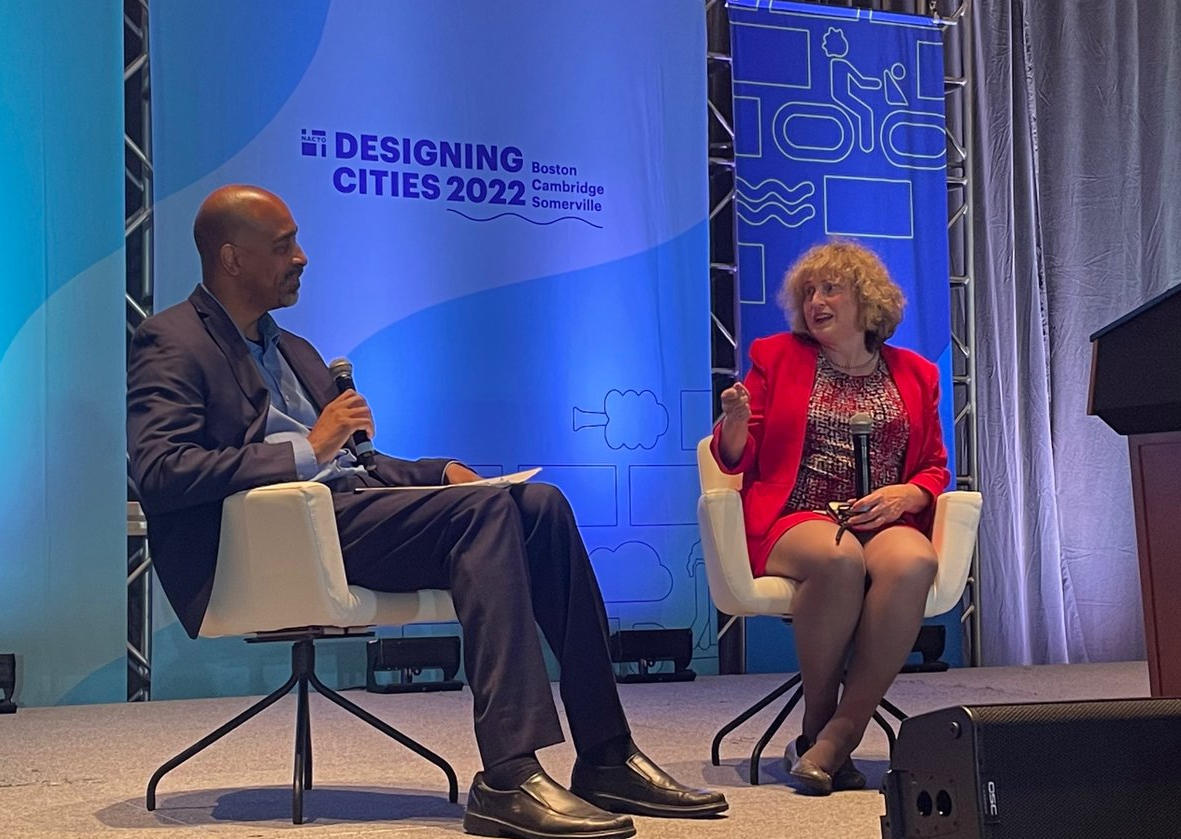
NACTO President Michael Carrol (left) and FHWA Deputy Administrator Stephanie Pollack (right) in a conversation at September’s Designing Cities conference in Boston. Photo courtesy of NACTO.
The annual conference of the National Association of City Transportation Officials (NACTO) conference in Boston earlier this month offered a sort of homecoming for Stephanie Pollack, the former leader of MassDOT who left for Washington in early 2021 to lead the Federal Highway Administration in President Biden's administration.
Pollack's return to Massachusetts coincided with the 30-day shutdown of the Orange Line and part of the Green Line – a consequence of inadequate staffing, deferred track maintenance, and other problems that festered at the T during Pollack's 6-year tenure as the state's Secretary of Transportation.
Fortunately, Pollack's record on building safer streets and prioritizing safety at MassDOT's Highway Division was considerably better. During her tenure, MassDOT launched the Massachusetts Complete Streets funding program, and also oversaw revisions to the state's engineering criteria for highway projects to require ADA-accessible pedestrian facilities and high-quality bikeways in state-run road reconstruction projects, plus bus shelters, crosswalks, and transit-priority infrastructure in road projects that affect major transit routes.
Now, as the Deputy Administrator for the Federal Highway Administration, Pollack is working on taking some of those same ideas to a national scale, and during the NACTO conference earlier this month, Pollack took the stage to deliver an hour-long talk on what she and her team have been working on. Here were some of the highlights.
Encouraging 'complete streets' in federally-funded projects
“I’m a huge fan of complete streets – streets that are safe, and feel safe, for all roadway users,” Pollack told the crowd attending her talk at NACTO.
In March of this year, the FHWA issued a report to Congress that recommended, among other things, making "Complete Streets FHWA’s default approach for funding and designing non-access-controlled roadways" and "adoption of standards and guidance that promote safety and accessibility for all users."
Pollack cited her experience in developing MassDOT's new design requirements for bike lanes and pedestrian facilities in state projects as an example of how new engineering requirements could create systemic change in an agency.
“Many of you may still believe that you have to design any road on the national highway system, or any project that uses federal funds in a very specific way, and in a way that some of you may be concerned doesn’t actually address the safety challenges and opportunities in your communities," Pollack told the audience at NACTO. "But in fact, over the past decade, the FHWA has embraced flexibility in the design process as it relates to safe roads... earlier this year, FHWA finalized changes to its design standards to encourage ‘the use of flexibility and a context-sensitive approach to consider a full range of project and user needs and the impacts to the community.’ So the rules of the game have changed."
Pollack said that the FHWA used to have 12 control criteria, which specified requirements like minimum lane widths. But since 2016, FHWA has eliminated all but 2 of those design criteria on any road where the design speed is 50 mph or less (the two remaining criteria govern design speeds and "loading structural capacity").
"There is no actual (FHWA) requirement for any particular lane width on any national highway system roadway in which the design speed is 50 mph or less," stressed Pollack.
Pollack also noted that during her tenure leading MassDOT, the agency successfully obtained FHWA’s permission to add new state-level controlling criteria to require sidewalks, safe bike facilities, and transit stops. California is currently working on similar state-level standards.
“All of your state Departments of Transportation are equally free not only to take away things like lane width requirements (in their own state-level design standards), but also to add in new ones that promote the kinds of safe roads that we are talking about this afternoon,” said Pollack.
A preview of MUTCD revisions
Pollack also talked about the "Manual on Uniform Traffic Control Devices," or MUTCD, which will have a new, revised edition released “by the statutory deadline” in May 2023.
The MUTCD has long been pilloried for encouraging reckless driver behavior and dangerously-designed roads through debunked standards like 85th percentile rule, which lets the most reckless drivers on a roadway set the posted speed limit.
The existing manual also has a notorious "blood sacrifice rule" for traffic signals: the manual says that crosswalks with traffic signals are not “warranted” at intersections where there are fewer than 93 pedestrians an hour, unless drivers cause five or more injury-causing crashes at that intersection in a given year.
Still, Pollack warned advocates against “overblaming” the MUTCD for bad roadway design decisions.
“(MUTCD) is not a roadway design manual. I understand that there are things in the MUTCD that in fact shape roadway design, but it is actually about traffic signals, pavement markings, and traffic control devices.”
“If you’re being told that the MUTCD won’t let you do some kind of design thing, and you can’t find it in the MUTCD, or if you get the inevitable ‘FHWA will take all of the state’s money away if you have a rainbow crosswalk,’ I think that’s a bit of an overstatement of the impact of the MUTCD.”
Safer speed limits
Pollack had a lot more to say about changes coming to the federal government's guidance for setting safer speed limits.
“The official policy of the U.S. Department of Transportation, as of the publication of the National Roadway Safety Strategy (published in January 2022), is that we prioritize safety and moving individuals at safe speeds over focusing exclusively on the throughput of motor vehicles," said Pollack, to applause from the audience. "We do hear you guys.”
Pollack discussed research from Boston, which announced a citywide speed limit reduction from 30 to 25 at start of 2017, as strong evidence that simply changing the number of speed limit signs could improve safety:
Setting appropriate speed limits with safe speeds, @Steph_Pollack cites the Boston data and research on safety benefits of just changing the number on the sign; also citing @TTITAMU NCHRP 17-76 report #NACTO2022 https://t.co/vrIIJzH8gV pic.twitter.com/zFLfINZbYv
— Peter Koonce (@pkoonce) September 8, 2022
"Changing speed limits, even in the absence of anything else, is in fact a proven safety countermeasure. It is proven to save lives," said Pollack.
This data from Boston's experience was cited in a new National Academies research study that recommended reforms in how agencies set posted speed limits.
"Our really well-done National Highway Cooperative Research Program (NHCRP) study notes that in setting speed limits, agencies should consider a range of factors like pedestrian and bicycle activity, crash history, land use context, intersections spacing… in other words, if people tell you that Federal Highway’s position is that the only thing that matters when you set a speed limit is speed distribution (i.e., the 85th percentile rule), that is not true," said Pollack.
And a request for city officials to do better with land use
During a question-and-answer session with NACTO President Michael Carroll, Pollack acknowledged that her federal agency has a large role to play in how transportation projects get designed and built – but there are also lots of things she can't influence.
“You are all entitled to come to us and tell us what we need to do, but I would also ask you to think about your lane," said Pollack. "One thing I’ll tell you is that's sitting underneath real change – and access to opportunity, and greenhouse gas emissions, and safety – is land use. There is almost no federal role in land use, and I doubt there ever will be. And many local transportation officials say ‘well, I don’t do land use,’ but you work for a city!”
“So one of the things we need to talk about more in our partnerships is the underlying drivers of transportation patterns, and that, my friends, is land use. We will never get where we need to be for greenhouse gas emissions in 5, 10, 50 years from now if we don’t have this conversation," said Pollack. "It is perfectly legitimate for you to say, ‘Federal Highway, we need you to do this, state DOT, we need you to do this,' but come to the table with something that you can do as a city that we can’t do.”
Stay in touch
Sign up for our free newsletter

